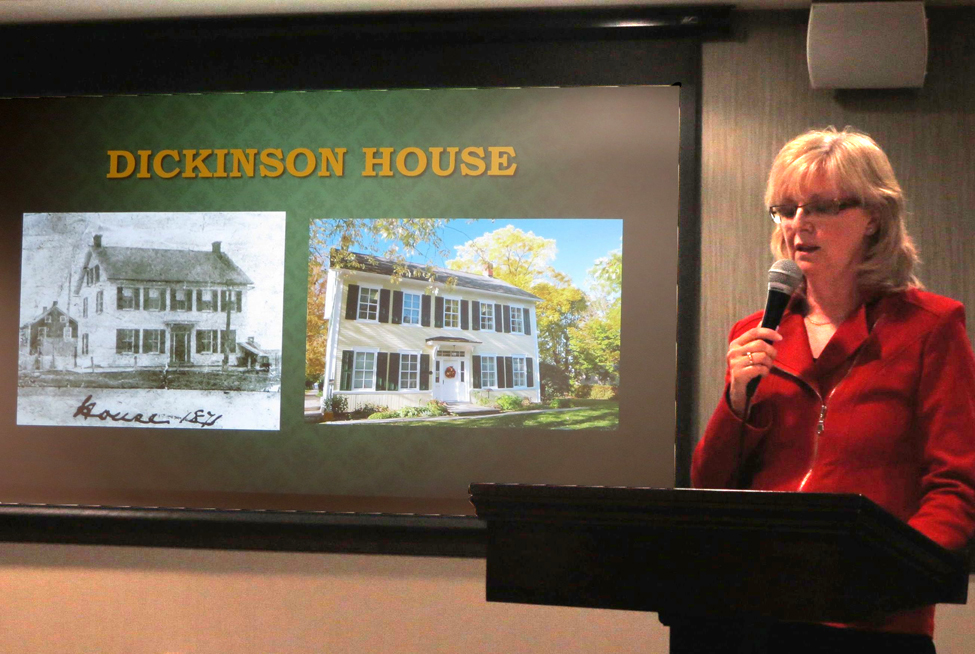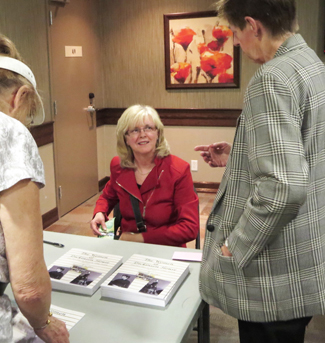The Women of Dickinson House and Their Place in Manotick Village Society, 1870-1930
The Women of Dickinson House and Their Place in Manotick Village Society, 1870-1930
Presentation by Maureen McPhee. Article and photos by Lucy Martin. September, 2014.
After a summer break, the September meeting sometimes feels like the start of a new year. This meeting also took place in a completely new venue: Orchard View on the Rideau, on Bridge Street in Manotick. One surprise was how much larger it feels from within than it looks from without. We enjoyed the use of a very sizable basement meeting room that easily accommodated the 39 people in attendance, including several Orchard View residents.
Our speaker, Maureen McPhee, is familiar to many as a very active volunteer, board member and officer at RTHS and Watson's Mill. Indeed, McPhee said it was volunteering at Dickinson House that generated the book. Visitors had questions about the Dickinson family and their era that volunteers could not answer. McPhee took to scouring archival records, including church histories and the minutes of the Manotick Women's Institute, to discover more about the women of Dickinson House.
McPhee says the hunt turned up more about all the Dickinsons, including a wealth of photos in the collections of Library and Archives Canada. It only made sense to share those findings with the public. She added that others in RTHS may produce a companion book about the male Dickinsons at some future date.
As many readers already know, construction began on the large house across from Manotick's grist mill in 1867. In 1870, mill owner Moss Kent Dickinson (1822-1897) and his five children moved from Ottawa to that new home. The children were: George L. Dickinson (1848-1930), Charlotte E. T. Dickinson (1851-1929), William B. Dickinson “Willie” (1853-1930), Lydia M. Dickinson (1857-1872) and Elizabeth H. Dickinson “Bessie” (1861-1933).
Moss Kent Dickinson's wife, Elizabeth Trigge Dickinson (1821-1861) died shortly after giving birth to Bessie. An infant son, Alpheus M. Dickinson (1855-1856) also predeceased the period covered in the book. Lydia lived at Dickinson House for only two years before dying of tuberculosis at age 15.
As the oldest daughter in what became a motherless family, Charlotte spent most of her life running Dickinson House for her father and siblings, none of whom married. The youngest in the family, Bessie, seemed to have more time to engage in community activities. McPhee deduced that Bessie, in particular, seems to have been broadly skilled and informed. It can be surmised the sisters had a close relationship. In terms of personality, or the tone of their lives, it would appear that Charlotte focused on work and (perhaps) appearance. Bessie seemed more demonstrative in terms of emotions like love and joy.
Historians frequently give scant attention to the domestic side of life, or the pursuits of churches and community organizations, easily dismissed as “women's work”. But McPhee agrees with British historian G.M. Trevelyan's statement: “Without social history, economic history is barren and political history is unintelligible.”
The best details regarding the lives of Charlotte and Bessie came from church records (including the St James Anglican Ladies' Guild and the Women's Auxiliary) and the Women's Institute. Bessie often served on the executive board of the organizations. As was deemed proper for that period, most of the activities undertaken by those groups consisted of fund-raising for charitable or missionary causes, and constructive contributions to the comfort and welfare of others. In this same period, the First World War is credited with expanding the role of women as wider ways to support the war effort were encouraged.
If that sounds somewhat dull and sedate, keep in mind there was also a household to run and practical support for two generations of business life conducted by the male Dickinsons. Besides various mill operations to oversee, portions of Dickinson House were (at times) a general store, a post office, a telegraph office and meeting place for local organizations, including the women's clubs. Dickinson House is also believed to have served as campaign headquarters for Sir John A. MacDonald when he ran for Parliament in the Carleton Riding in 1887. There was enough going on to keep all the siblings quite busy!
The records McPhee searched included details and surprises, such as the revelation that Charlotte and Bessie attended different churches (Presbyterian and Anglican, respectively). A pleasant discovery was how cordial relations seemed to be between different denominations and congregations in the area.
Bessie lost all of her adult siblings in a short period between 1929-30. With their passing, and in ill-health herself, she relocated to Ottawa somewhere between 1930-31. She died there in 1933. The mill was sold to the Spratt family in 1929, who purchased Dickinson House as well in 1930.
There were a number of post-talk questions. Did the Dickinsons have connections with the Orange Lodge? No connection was found. McPhee did discover evidence the Dickinsons and the Manotick Women's Institute could have taken up the cause of temperance, but declined that opportunity.
Although Charlotte and Bessie were clearly educated, literate women, it has yet to be discovered where they went to school - if they attended formal school at all. Some women of that class attended a Ladies College in Ottawa, but no such evidence was uncovered regarding the Dickinson daughters.
Did McPhee come across any signs of romance in the lives of Charlotte or Bessie? No, but that's not surprising as church records and W.I. Minutes are not where that would normally come up.
In the course of her talk, McPhee mentioned she had not envisioned writing a book as part of her retirement plans. More proof that RTHS members are lured into unexpected adventures and contributions! (Her book may be purchased at cost for $15 at Dickinson House or at the Rideau Branch of the City Archives in North Gower, open each Tuesday.)
Thanks as well to Orchard View on the Rideau for their hospitality. Indeed, the Mill Quarter continues to serve as an important social hub for Manotick and beyond.


